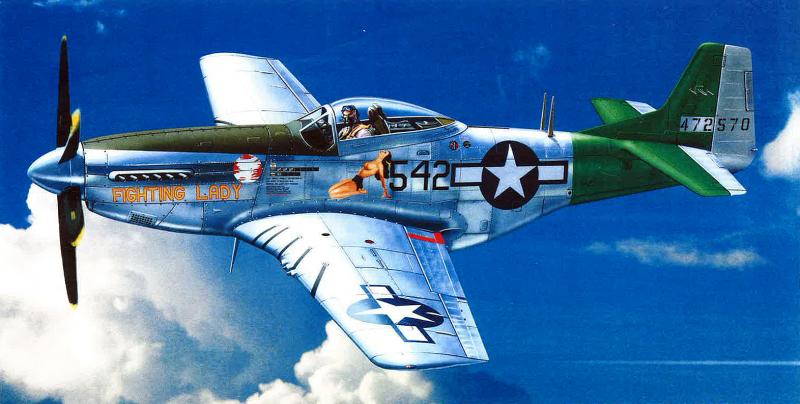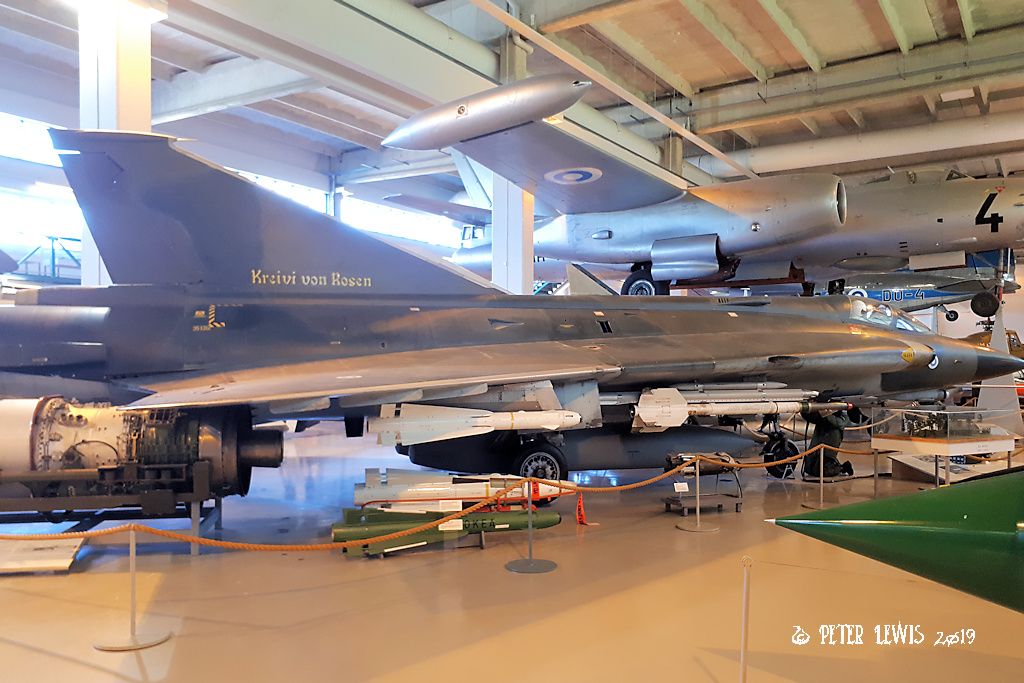|
|
Post by Peter Lewis on Sept 13, 2019 18:08:43 GMT 12
The Messerschmitt Bf 109G, nicknamed “Mersu” (like Mercedes-Benz cars), was perhaps the most publicly famous fighter aircraft type to be flown by the Finnish Air Force. On 1February1943 a contract was signed with Germany for these fighters.
Finland received 48 Bf 109G-2 aircraft which, after a brief familiarization course in Germany, were flown to Finland by their new pilots between March and May 1943. The Bf 109G-2 achieved its debut kill in 24March1943 when WO (Lentomestari) Ilmari Juutilainen shot down a Soviet photoreconnaissance Pe-2 near Suursaari.
Finland was able to buy another 30 Messerschmitt Bf 109G-6 aircraft after the Leningrad island ring broke in January 1944.
Later, 82 more G-6s and three G-8s were purchased.
In total, 159 Bf-109s were taken into service, as two of the G-6s and one G-8 were destroyed en route to Finland. Forty-eight of these were G-2s, 109 were G-6s and two were G-8s. The last of the purchased aircraft arrived in Finland on 20 August 1944, just before the armistice with the Soviet Union. The Bf 109 is still the aircraft type that has served in the largest numbers in the Finnish Air Force. With the arrival of the 109s, the Finns once again could fight on a more even basis, as they could match the latest Soviet fighters. During the Continuation War Bf-109s were in service with fighter squadrons 24, 28, 30 and 34. The Finns scored 667 confirmed victories with the type in the Continuation War, losing 34 Bf 109s to enemy fighters or anti-aircraft fire. A further 16 were lost in accidents and eight aircraft were destroyed on the ground. Twenty-three pilots were killed. One hundred and two Bf 109s survived the war and the aircraft remained the main fighter of the Finnish Air Force for almost a decade until the spring of 1954, when the FAF entered the Jet Age. Bf 109 G-6/Y 167271, ex-VO + GI, ex-Finnish AF MT-507 "Yellow 0" Werk No. 167271 Delivered to FAF 24Aug1944. Went into storage after just 10 hours of flight after the armistice with the USSR in September. Returned to service Jun1949 until it carried out the last FAF Bf-109 flight on 13 March 1954, pilot Major Erkki Heinilä. The aircraft served as a monument to Utti until 1970, when the aircraft was finally moved to the Finnish Air Force Museum. 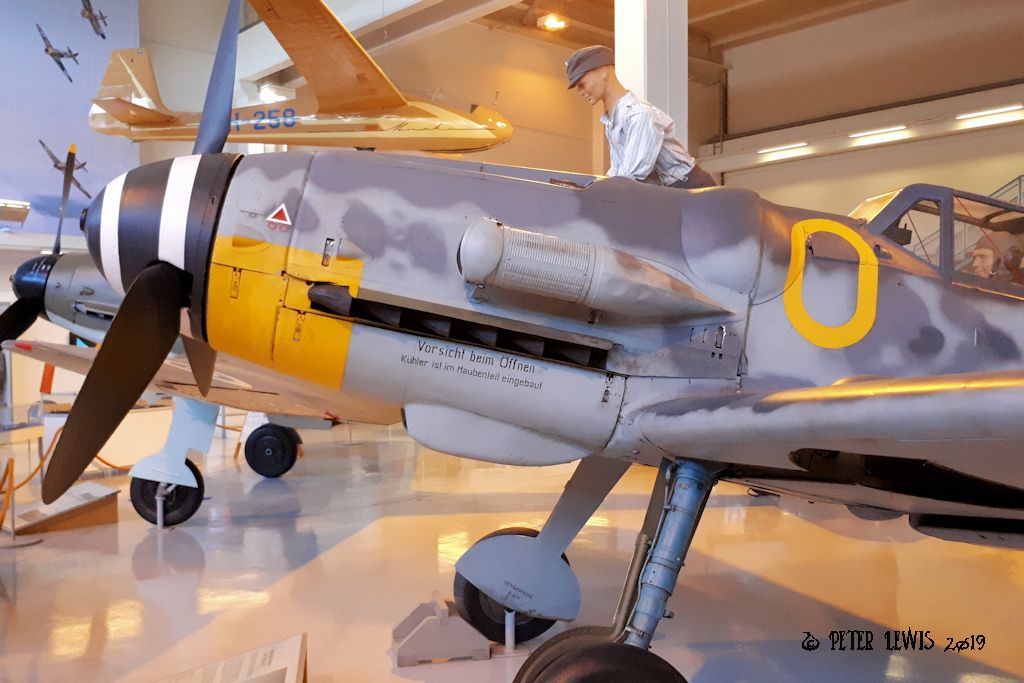 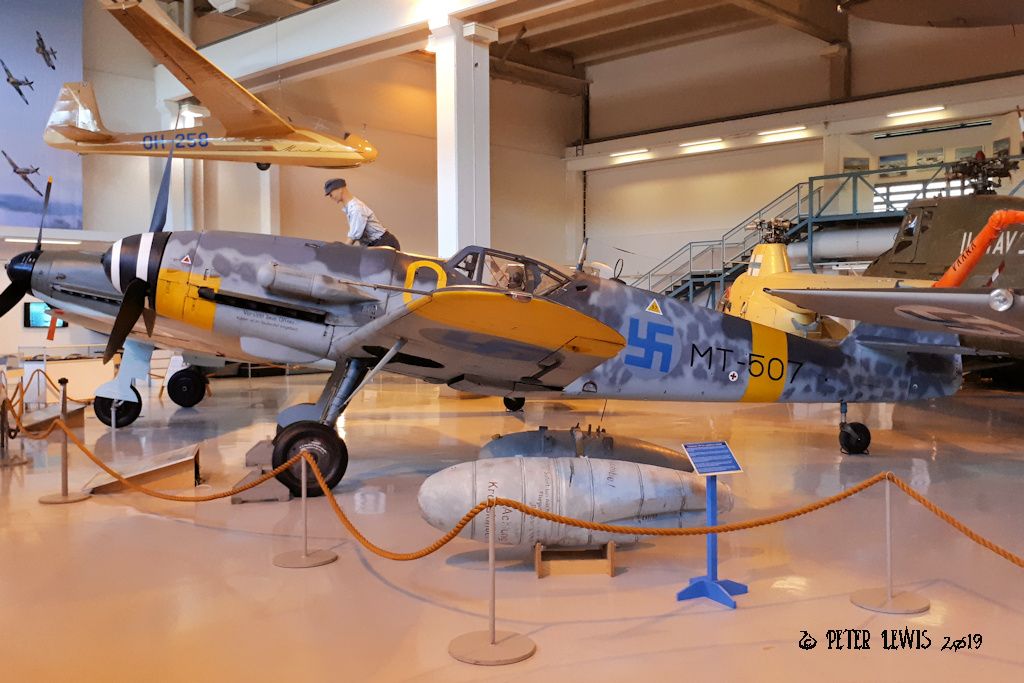 |
|
|
|
Post by FlyingKiwi on Sept 13, 2019 20:07:47 GMT 12
Well phasselgren, inadequate for everyone else.  Dave, I wonder was it the aircraft's characteristics they didn't enjoy or the fact they were sitting ducks if they got shot at? I've never heard of them having any particular vice of handling - just slow and clumsy compared to most of their contemporary fighter opposition. But I can't claim to have personally spoken to anyone who has actually flown one. |
|
|
|
Post by Dave Homewood on Sept 13, 2019 22:39:37 GMT 12
It was the flying characteristics. They just were not nice to fly. Most of the guys I met that flew them had flown then in Fleet Air Arm training in the USA with the US Navy. They went from the N3N to naval Stearman to SNJ (Harvard). Then onto the Buffalo which was the phase they all hated, and then if they survived that onto the Wildcat and finally the Corsair where they formed up in squadrons. I think the US Navy's training ones would have been pretty well used, hammered by students, and just tired, compared with the ones in Singapore fresh out of the factory crates.
|
|
|
|
Post by phasselgren on Sept 14, 2019 6:01:17 GMT 12
Actually the pilots in the Netherlands East Indies Army Air Corps held the Buffalo in high esteem but they were too few to be able to affect the japanese onslaught.
Qoute from Aircraft of the Netherlands East Indies Army Air Corps in crisis and war times, February 1937 - June 1942 by Dr P.C. Boer: "Altough not a good climber, up to at least 6,000 metres its turning radius with half filled wing tanks and half to three quartes filled wing ammuntion bays was as good as that of the Ki-43 and the Navy 0, which it could both easily out-dive." Not many aircraft could match the Ki-43 and Zero in turning radius.
Peter: Great photos and I really enjoy reading your posts.
|
|
|
|
Post by Peter Lewis on Sept 14, 2019 17:26:52 GMT 12
The VL Pyörremyrsky (Hurricane) was a Finnish fighter, designed by DI Torsti Verkkola at the State Aircraft Factory for service with the Finnish Air Force in World War II. The goal was to at least equal the performance of the Messerschmitt Bf 109G. The war ended before the type's first flight and although two machines were ordered only one prototype was completed. As many parts as possible were made of wood, which was easily available in Finland. Finnish engineers developed a single-spar wooden wing unit running through the fuselage, while a plywood skinning technique was employed externally for a smooth aerodynamic finish. The engine and the propeller were taken from the Bf 109G. The landing gear was significantly widened and installed on the wing instead of fuselage in order to address one of the German fighter's most noteworthy shortcomings. Proposed armament was a hub-mounted 20mm MG151 canon and a pair of wing mounted 12.7mm LKK/42 series machine guns. There were also plans for a pair of underwing hard-points for 440lb conventional bombs. The Pyörremyrsky prototype PM-1 made its first flight on 21 November 1945 at Härmälä, piloted by Esko Halme. The aircraft was to fly only three test flights in Tampere, the third time being a transfer flight to Kuorevesi on 16Jan1946. There it flew an additional 31 test flights, the total flight time being 27 hours by 1947. The aircraft was flown by eight pilots: Esko Halme, Lauri Hämäläinen, Erkki Itävuori, Osmo Kauppinen, Lasse Heikinaro, Martti Laitinen, Heikki Keso and Lauri Lautamäki. The last flight lasted only 20 minutes and was made by captain Osmo Kauppinen on 22Jul1947. The Pyörremyrsky design was considered quite successful. It could outclimb the Bf 109G-6 and it was very manoeuvrable. It was considered almost ready for mass production. Its only major problem with the design was found to be the low-quality glue used in the joints. The aircraft was still at the prototype stage when the war ended and this also meant an end to the funding for the project. Sufficient Bf 109Gs remained in service to equip the fighter force that was permitted under the Armistice terms.
The PM-1 was removed from FAF lists on 1Apr1953 with an order for it to be stored for a future museum, and the aircraft was restored to display condition at the Tampere depot 1970-1972. 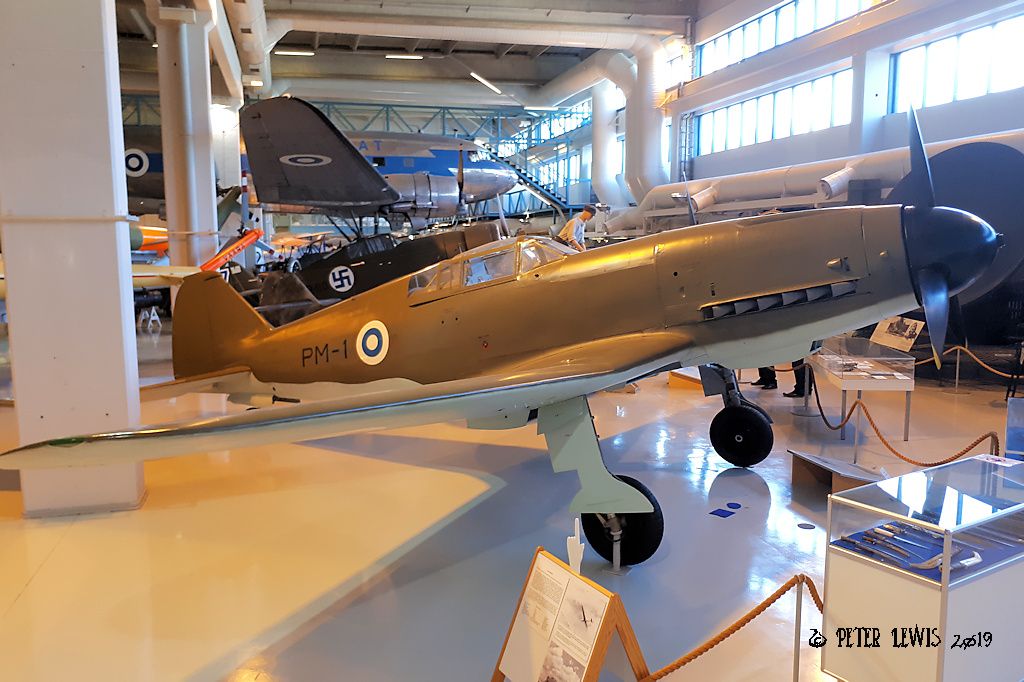 Interesting to note that the prewar/wartime blue swastika markings have been replaced with the post-war blue roundel. |
|
|
|
Post by Dave Homewood on Sept 14, 2019 18:21:02 GMT 12
Wow that is a really nice looking fighter, and interesting.
|
|
|
|
Post by vultee43 on Sept 15, 2019 0:32:38 GMT 12
Great looking aircraft. Another Scandinavian design to never see it's full potential.
|
|
|
|
Post by Peter Lewis on Sept 15, 2019 22:06:40 GMT 12
Slightly more successful was the VL Myrsky (Storm) designed by the State Aircraft Factory for the Finnish Air Force. The Finnish Air Force requested preliminary proposals for a domestic fighter from State Aircraft Factory (Valtion Lentokonetehdas) in early 1939, before the Winter War. The Ministry of Defence ordered the fighter design into production in June 1939. Due to difficulties obtaining duraluminium, the wings were made out of plywood and the fuselage was metal structure with a fabric and plywood skin. A Pratt & Whitney R-1830 (civil Twin Wasp) was the engine chosen. Availability of this engine was problematic, so an R-1830-S3C3-G was used for the first prototype and less-powerful SC3-Gs for later prototypes and production fighters. These were bought from German war booty stocks. The first Myrsky prototype flew on 23 December 1941. The prototype was fully functional, but too heavy. After some modifications they soon had three new prototype aircraft. The test flights showed some structural problems during high-speed tests. All three prototypes were destroyed during test flights. Two test pilots died, one was seriously injured. The culprit was found to be aeroelastic flutter, which was a poorly known phenomenon at the date. Resolving the flutter problem took almost a year. Series production started in autumn 1942, well before German deliveries of Messerschmitt Bf 109 began in 1943. The series production version was called the Myrsky II. 47 Myrsky IIs were built and together with the Myrsky I version and Myrsky prototype the production total was 51 aircraft. Although the aircraft met the specifications set for it, it did not fulfill all expectations due to structural problems. Reconnaissance Squadron 12 received their first Myrskys during August 1944. Thirty Myrskys were delivered to Reconnaissance Squadrons 12 and 16 before the end of the Continuation War. The war time Lukko glue, manufactured from ersatz materials, which was used for gluing the wooden parts, did not stand rain, frost and humidity, and the glue seams disintegrated, sometimes with disastrous results. Ten Myrskys were lost in accidents between 1943 and 1947 and four pilots died. Myrsky usage ended in May 1947 and the last Myrsky flight was in February 1948. The Myrsky proved fast and manoeuvrable enough to dogfight the contemporary Soviet aircraft; it was the second fastest Finnish Air Force aircraft after the Messerschmitt Bf 109G. Pilots liked the plane as it had good cockpit ergonomics and decent flight and ground handling properties. Its wide undercarriage gave it decent ground-handling properties. Its main drawback was the construction method, the ersatz materials simply did not stand the harsh Finnish weather. Three Myrsky fuselages and several parts have survived. The Finnish Aviation Museum displays the naked fuselage of MY-14 and apparently also has MY-5. 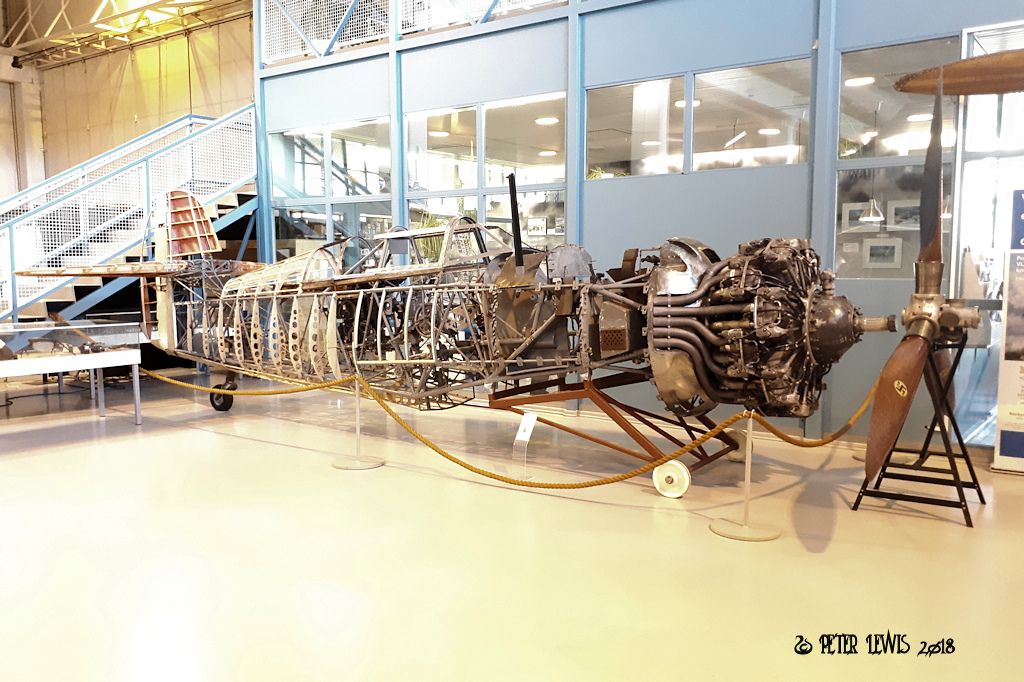 |
|
|
|
Post by Peter Lewis on Sept 16, 2019 19:28:32 GMT 12
The end of the Continuation War brought Air Force operations to an almost complete stop. An aviation ban imposed by the Allied Control Commission, effective from the armistice of autumn 1944, interrupted all training and exercise activities until lifted in August 1945. The arrival of peace also meant equipment reductions and operational changes across the Service. The Paris Peace Treaties signed in 1947 regulated, among other things, that the Finnish Air Force was to have no more than 60 combat aircraft and a maximum strength of 3,000 persons. The treaties also banned the Air Force from having aircraft with internal bomb bays as well as guided missiles and atomic weapons. A key milestone in the modernisation of the Service was the 1951 introduction of the Vihuri advanced training aircraft, designed and built by the State Aircraft Factory.
Valmet Vihuri (Finnish for Gale) was a Finnish advanced two-seat fighter trainer aircraft, serving in the Finnish Air Force between 1953 and 1959. In spite of their economic problems, the aircraft manufacturer Valmet had begun designing a new aircraft at the beginning of the 1950s to replace the aging previous trainer aircraft. The Bristol Mercury, then being manufactured under license in Finland for the Bristol Blenheim bomber, was chosen as the engine, since it was readily available. The prototype (VH-1) made its first flight on 6 February 1951, in Tampere, piloted by captain Esko Halme. After successful test flights, the FAF ordered 30 production aircraft, called Valmet Vihuri II, on 27Feb1951. In the autumn of 1954, the Air Force ordered a further 20 aircraft of the developed version Valmet Vihuri III. All the aircraft of the third version were handed over to the Air Force on 15Jan1957. The Vihuri became the most-used aircraft in FAF service by the mid-1950s. The type was involved in a number of accidents that were widely publicised, but it was nevertheless significant for the Air Force. It brought much-needed relief into the equipment situation and kept the wheels of flying training rolling until the decade's end. In May 1959 the type was permanently grounded after the death of the Finnish prime minister's son in one. Only a few airframes have survived, such as VH-18 displayed here. 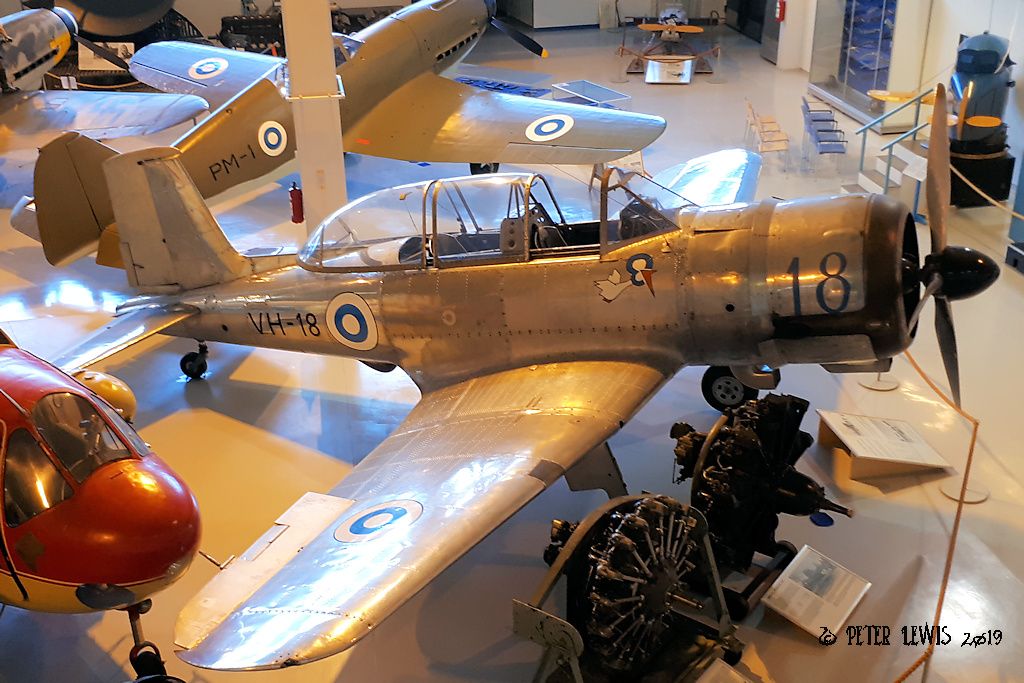 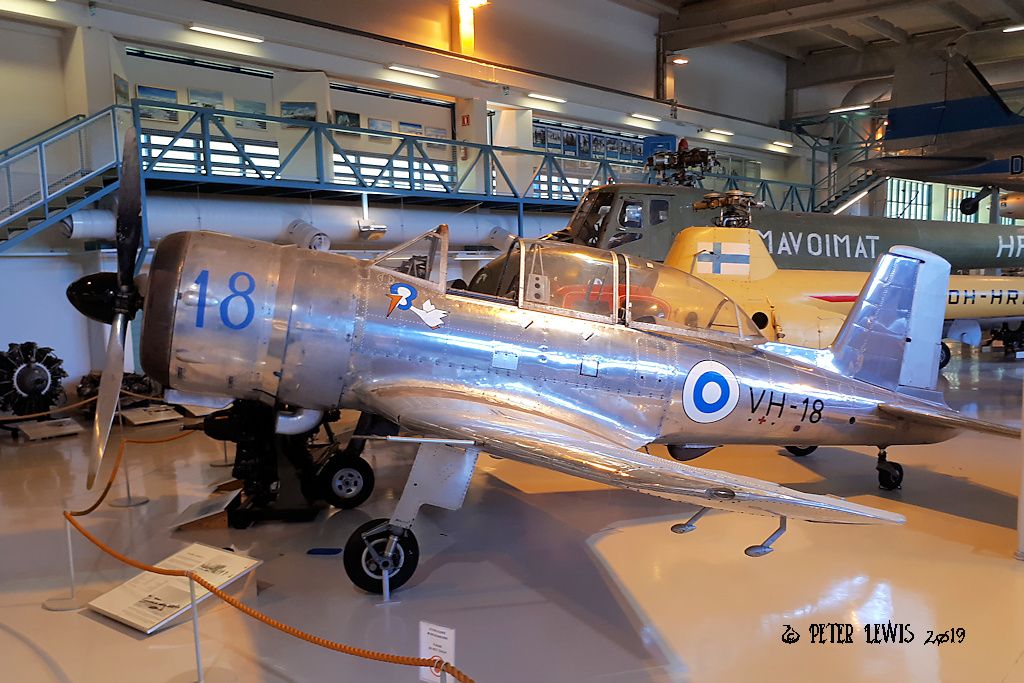 |
|
|
|
Post by Peter Lewis on Sept 17, 2019 18:21:06 GMT 12
In 1953 the Finnish Air Force received its first jet aircraft by procuring DH Vampires from the UK. The Air Force received six FB.52 Vampires in 1953. The model was nicknamed "Vamppi" in Finnish service. An additional nine two-seat T.55s were purchased in 1955. The aircraft type was the first jet trainer in Finland as well as the first aircraft type equipped with ejection seats. The Vampires proved reliable and pleasant to fly, though maintenance proved more difficult than expected in the Arctic winter conditions. Due to their intensive use and the rapid pace of technical development, their career in Finland was short. The last flight of a type in the Finnish Air Force was flown with the VT-8 on July 15th 1965 and this is the aircraft now on display at the museum They also have a FB.52 VA-6 in storage. 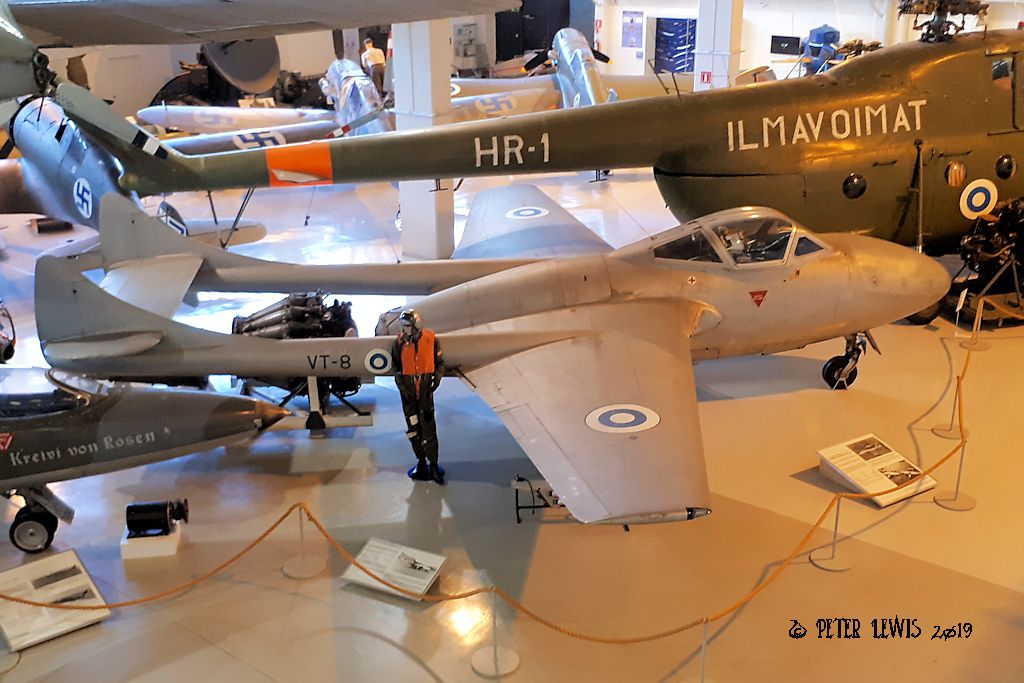 The Vampire was succeeded by the Folland Gnat, a more capable jet fighter, again from the UK, acquired in 1957. The Finnish Air Force received the first of its 13 Gnats (11 fighters and 2 photo-reconnaissance planes) on 30 July 1958, and they earned the nickname Nutikka ("Stubby"). As with the Vampire, the Gnat F.1 proved initially problematic in the harsh Finnish conditions. Finland was the first operational user of Gnat F.1 and the plane still had many issues yet to be resolved. All Gnats were grounded for half a year on 26 August 1958 after the destruction of GN-102 due to a technical design error in its hydraulic system, and the aircraft soon became the subject of severe criticism. Three other aircraft were also destroyed in other accidents, with two pilots ejecting and one being killed. Once the initial problems were ironed out, the plane proved to be extremely manouevreable and had good performance in the air, but also to be very maintenance intensive. Interestingly, a Gnat broke the sound barrier for the first time in Finland. The Gnats were removed from active service in 1972 when the new Saab 35 Drakens were brought into use. GN-101 flew on the last flight of the aircraft type on October 24, 1972. Several Finnish Gnat F.1s still survive either as museum pieces or memorials. One airframe, GN-113, is in private ownership There are two Gnats at the museum: GN-101 "Kreivi von Rosen" inside and GN-104 on outside display. 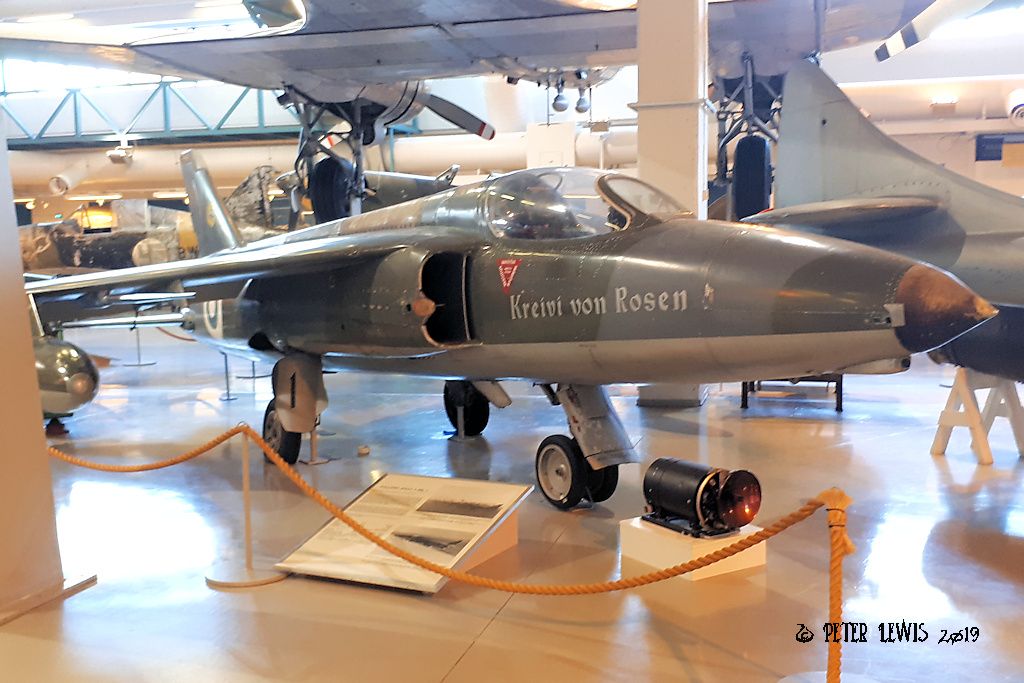  |
|
|
|
Post by denysjones on Sept 17, 2019 20:32:07 GMT 12
Peter I don't know if you know of the complete Myrsky replica project that's well advanced www.vlmyrsky.fi/blogi.htmlstunning stuff even if Google translate does yield some interesting reading! cheers |
|
|
|
Post by Peter Lewis on Sept 17, 2019 21:53:17 GMT 12
Yes I had heard of it Denys.
Hope they use better glues this time!
|
|
|
|
Post by Mustang51 on Sept 18, 2019 12:10:04 GMT 12
Read Buffalos Over Malaya...........inadequate performance, poor engine reliability......not something to face an A6M with. I too would love to see one flying and followed the trail of the one now shown on these pages till it went cold in Ireland. Very nice to see it back where it belongs...
|
|
|
|
Post by Peter Lewis on Sept 19, 2019 22:29:21 GMT 12
The Saab 91D Safir is a Swedish four-seat trainer aircraft. The design flew its first flight on November 20, 1945. In the spring of 1958, Finland decided to abandon the development of the Valmet Wind III and to purchase Safir aircraft. 35 new machines were obtained between 1958 and 1963. In addition, a civilian Saab 91B Safir was purchased in 1967 and converted to a D model. The Safirs served as training machines at the Air War School in Kauhava and as liaison machines in all units until 1982. Three Saab Safirs were then transferred to the Border Guard and 14 were sold for civilian use. 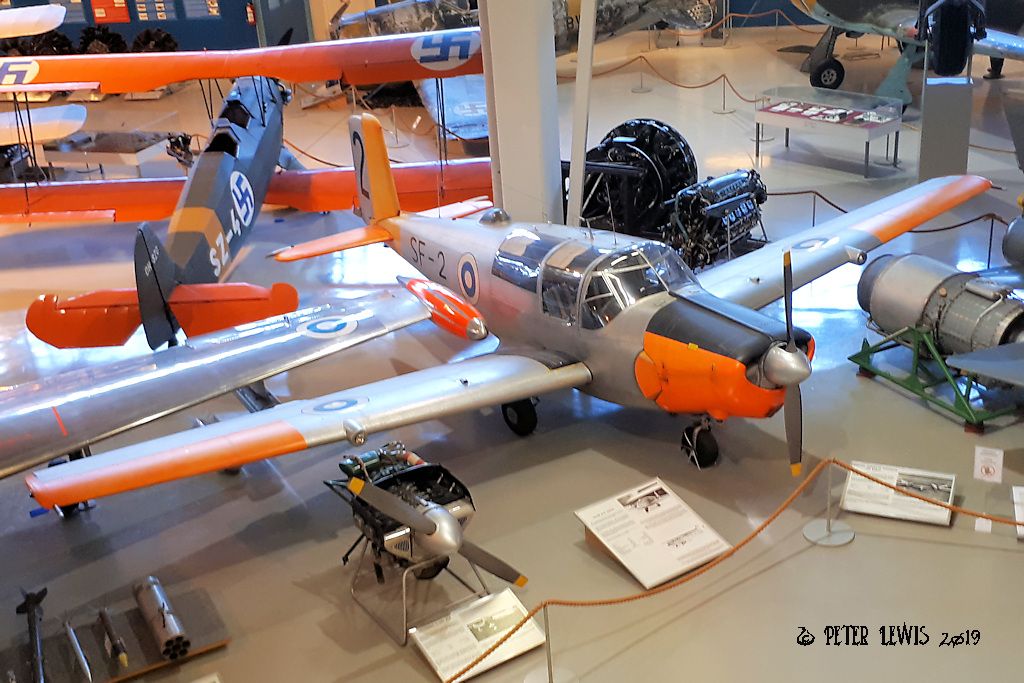 In April 1958, the Finnish Ministry of Defence chose the Fouga Magister as the new jet trainer, over the competing Hunting Jet Provost and Miles Student. The Fouga acquisition also included a license agreement to construct the aircraft at the Valmet factory. This was a vital step for the Finnish aircraft industry, which had been significantly cut down after the War, and which had then suffered a serious stain in reputation due to the Vihuri accidents. The first eight aircraft purchased from France were ferried already by the turn of 1958 – 1959. The first 22 aircraft manufactured by Valmet were handed over between 1960 and 1962. Altogether, the Finnish Air Force had 80 Fouga Magisters, of which 62 were manufactured in Finland – the last Fougas entered service in 1967. In due course, the British BAE Hawk was chosen the replace the Fougas. The last Fouga flight of the Finnish Air Force was flown 19Dec1988 – exactly 30 years after the first Fouga Magister landed in Finland. After the Fougas were decommissioned, 19 aircraft were sold to the United States, and four to Finnish civil buyers The rest of the aircraft ended up in Aviation Museums, as memorials, as instructional airframes or were scrapped.  |
|
|
|
Post by Peter Lewis on Sept 20, 2019 18:09:23 GMT 12
The first airline in Finland was established in 1923. Presumably after extensive (and expensive) discussions with PR consultants and market research experts this airline was named 'Aero'. Aero operated during the War Years as a Civil Squadron under the Finnish Air Force. After WW2 Aero’s entire fleet was worn out. The State of Finland took a controlling interest in the company (which was eventually renamed Finnair) bought ten C-47s from the U.S. surplus stocks and these were converted to airline configuration. The resultant DC-3 aircraft flew with Finnair until the 1960’s when they were replaced by F-27 Friendships and the survivors went to the Air Force. Thus the Finnish air force were one of the last in the world to actually acquire C-47s. C-47 43-48254 was built in Oklahoma City in 1944. The aircraft was converted from the C-47A-30DK to the passenger version DC-3C-S1C3-G at the State Aircraft Factory. Served with Aero/Finnair as OH-LCF until 27Feb1960 when it was transferred to the Air Force. Reserialled DO-4 and served as a transport aircraft until 27May1982, when it moved to the Finnish Air Force Museum. Total flight time a relatively light 28,576 hours.  |
|
|
|
Post by Peter Lewis on Sept 21, 2019 18:25:19 GMT 12
The Ilyushin Il-28 was the Russian Canberra bomber. Over 6,635 were built, and the type was widely used in Eastern Bloc, Asian and third-world countries. Two used Il-28 aircraft were purchased for the Finnish Air Force between 1960 and 1961, and two more in 1966. One of the aircraft was an IL-28 and three were IL-28R. The first Finnish Il-28 aircraft, "NH-1", landed on Utti's airfield on January 28, 1960 . The Finnish aircraft designation for this aircraft "NH" was the same as the initials of Soviet leader Nikita Khrushchev (Finnish spelling; "Nikita Hruštšov") and this soon led to the aircraft being nicknamed "Nikita" or "Nikke". NH-2 arrived in Finland on June 23, 1961 and the last two in January 1966. As the Finns were prohibited from operating aircraft with integral bomb-bays, the type was used in land towing, mapping, maritime surveillance, reconnaissance and atmospheric sampling. The last flight of a Finnish Il-28 was flown by NH-3 on 30Jun1981. The museum display aircraft is Il-28R NH-4. 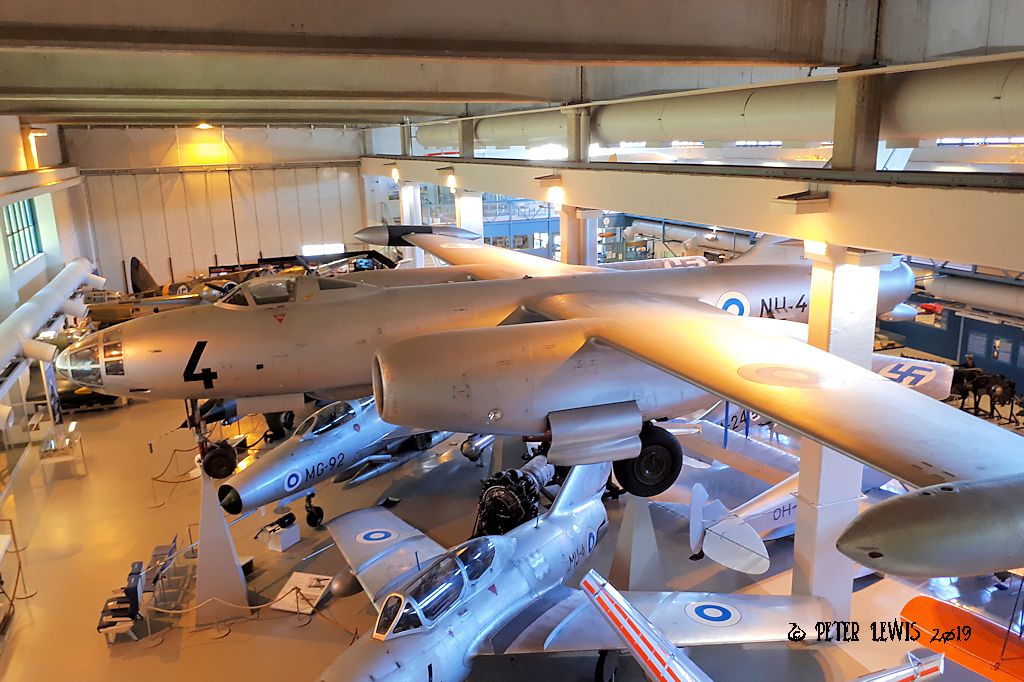 In 1962 the Finnish Air Force acquired a squadron's worth of MiG-21F fighters from the Soviet Union. The MiG-21 fleet was comprised of 22 MiG-21F-13, two MiG-21U and four MiG-21UM. The MiG-21F was an up-to-date and capable fighter at the time of acquisition, even in international comparison; it achieved Mach 2 and its service ceiling was almost 20 km. Its combat capability was improved with the K-13, an infrared homing air-to-air missile that the Air Force was allowed to procure pursuant to a negotiated amendment of the Paris Peace Treaties. There is a story that the Soviets allowed the Finns to acquire these aircraft in return for receiving a number of embargoed DEC computers from Finnish sources. The last of the MiG-21s were retired in 1986. 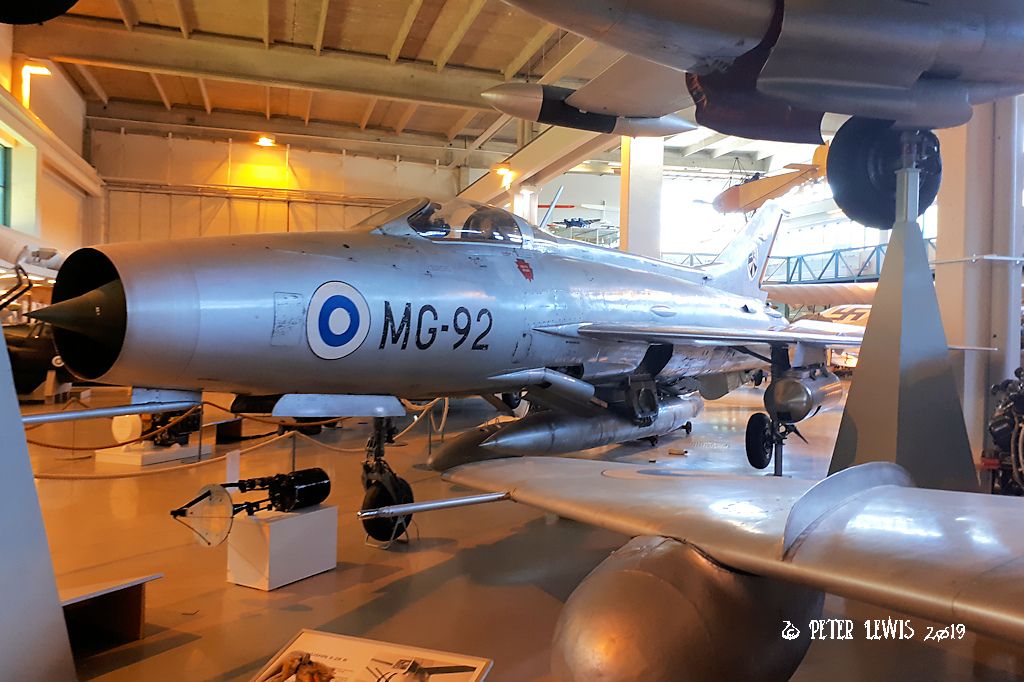 |
|
|
|
Post by phasselgren on Sept 21, 2019 21:45:14 GMT 12
Peter,
Is it a photo-recce pod under the wing of the MiG-21?
Regards
Peter
|
|
|
|
Post by Peter Lewis on Sept 22, 2019 17:29:46 GMT 12
Is it a photo-recce pod under the wing of the MiG-21?
My technical knowledge does not extend that far, sorry.
|
|
|
|
Post by Peter Lewis on Sept 22, 2019 17:48:14 GMT 12
The Saab 35 Draken (Dragon') is a Swedish fighter aircraft developed and manufactured by Saab between 1955 and 1974. It was the first fully supersonic aircraft to be deployed in Western Europe. In 1970 Finland decided to obtain the Draken, arranging to buy twelve "J-35S" AKA "J-35XS" interceptors in kit form for local assembly by Valmet. "S" stood for "Suomi", meaning "Finland". These machines were similar to the J-35F, but had twin Aden cannon and a revised avionics suite. Initial flight was in 1974, with deliveries completed in 1975. The Finnish Drakens served in both the interceptor and fighter-bomber roles. As an interim measure to provide training experience before the J-35XS fighters were available the Finns leased six J-35Bs from Sweden, giving them the designation "J-35BS". These aircraft were apparently stripped of most of their combat avionics. The first was delivered in 1972. One was grounded after being badly damaged in 1974, and the Finns leased another J-35B to replace it. In 1975 the Finns decided to buy these seven aircraft outright, since they had become enthusiastic about the type, and also bought six refurbished Swedish J-35Fs with the designation of "J-35FS". They bought a second batch of J-35FS Drakens in 1984, again all refurbished Flygvapnet aircraft. In addition to the refurbished fighters, in 1975 the Finns obtained three refurbished Sk-35C trainers with the designation of "Sk-35CS", and purchased two more refurbished J-35CS in 1984, along with the second batch of J-35FS Drakens. This somewhat complicated history gave a total Finnish Draken force of six J-35BS, five SK-35CS, 24 J-35FS and 12 J-35XS versions, 47 in all. The Drakens were operated alongside the Finnish MiG-21s until the 1990s. The Draken deal meant that roughly half of the fighters of the Finnish Air Force came from the West and half from the East. During the 1990s Finland updated its J-35XS fleet with new avionics, cockpit displays, navigational/attack systems, and electronic countermeasures. The Finnish Drakens were finally retired in 2000 to be replaced by F/A-18 Hornets. The aircraft on display is J-35FS D-223, and the museum is listed as having three other examples in their collection.
|
|
|
|
Post by phasselgren on Sept 23, 2019 6:24:40 GMT 12
Is it a photo-recce pod under the wing of the MiG-21? My technical knowledge does not extend that far, sorry. I have read that some MiG-21F were transferred to a reconnaissance unit but have not found any info on how these aircraft were modified. Anyway it looks like a photo-recce pod. |
|






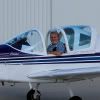

 Dave, I wonder was it the aircraft's characteristics they didn't enjoy or the fact they were sitting ducks if they got shot at? I've never heard of them having any particular vice of handling - just slow and clumsy compared to most of their contemporary fighter opposition. But I can't claim to have personally spoken to anyone who has actually flown one.
Dave, I wonder was it the aircraft's characteristics they didn't enjoy or the fact they were sitting ducks if they got shot at? I've never heard of them having any particular vice of handling - just slow and clumsy compared to most of their contemporary fighter opposition. But I can't claim to have personally spoken to anyone who has actually flown one.









